- Joined
- Apr 24, 2015
- Messages
- 20,942




























Dev Message and PAX East Demo Videos!

Hey Folks!
New video day! You've been very patient, waiting for a new video since...gosh, was it December? With the rush to get ready for PAX, my video game has been lax. (Sorry, dad pun+rhyme combo.) So to reward your patience, you get TWO videos!
Dev Update Vlog
This first video is a personal message from the developer, found on a derelict Ryokka tug outside of K-Leg:
Ostranauts: Developer Update, March 26th 2042 [RENBAO-COMPATIBLE]
In it, I talk about how PAX went, recap what Ostranauts is about, and the road to Early Access Launch.
PAX East 2020 Demo Walkthrough
The second video has me narrating a walkthrough of the demo from PAX East 2020, for those who couldn't attend:
PAX East 2020 Demo
It includes a demonstration of the captain creation process, salvaging a derelict, starting the inertial confinement fusion reactor, screening prospective crewmates, and the experimental flight controls.
If this sounds interesting to you, please wishlist Ostranauts on Steam here. Wishlisting is one of the most effective ways of helping the game succeed before launch, as it tells Valve this game is going to be a big deal!
And if you know anyone else who might dig this type of game, let them know! Spreading awareness is something everyone can do to help me continue to make games like this.
Thanks for your time, and stay tuned for more spacelife news!












Meet Dan Fedor, the man that wants us dead [ENG]
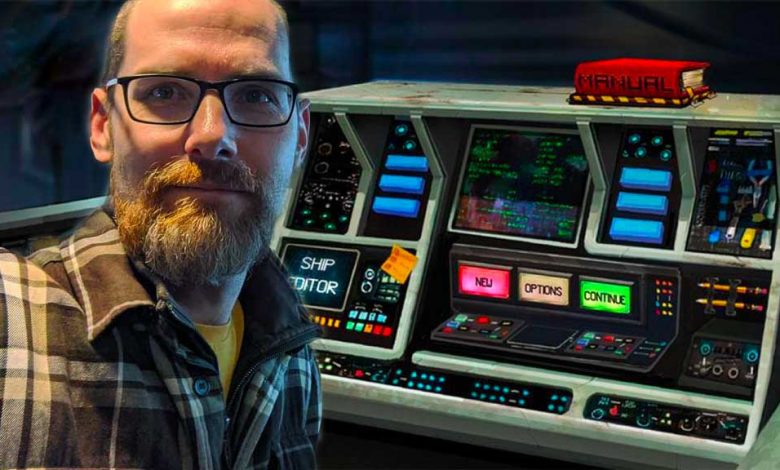
Dan Fedor is the creator of the indie sci-fi roguelite NEO Scavenger (find our review here [ITA]) and with his Blue Bottle Games he is currently working on a new project: Ostranauts. We managed to have a little chat with him about this upcoming game!
Marco M. for TCG: Hi Dan, and thank you for having found some time for us! The title of this interview is, of course, ironical: NEO Scavenger was a very hard game, but you got the skills to make it as hard as fun. Anyway, it was clearly not a game for everyone. Is Ostranauts going to have the same hardcore approach or your plans are to make it more friendly?
Daniel C. Fedor: I think Ostranauts will have the same attention to detail, and consequences for choices. Both of those qualities are important to me, and I like games that have them. So I want players to feel like the choices they make have weight, but also that the weight is logical. As for permadeath, I’m still feeling that system out. It’ll depend on how playtesting goes.
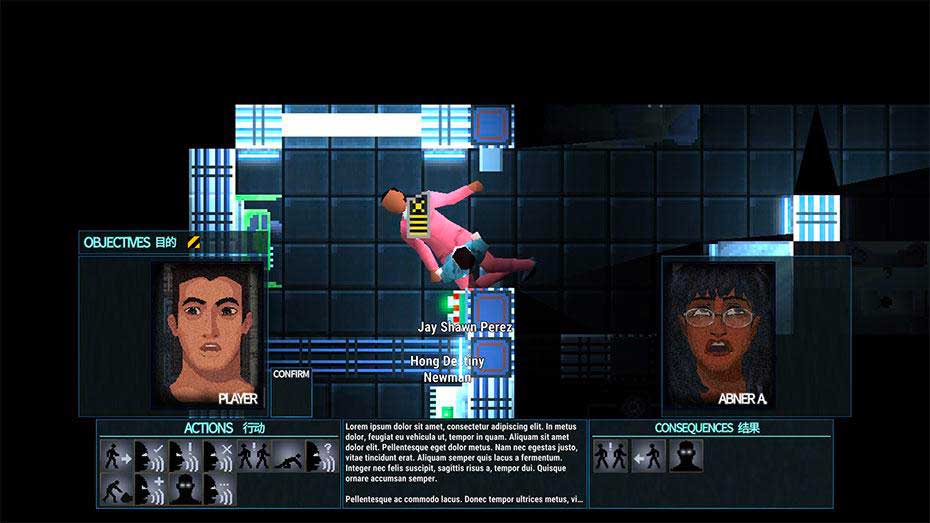
Every action a reaction.
TCG: When did you start to work at Ostranauts?
DF: The first prototypes for Ostranauts were started in 2015. Almost exactly 5 years ago! Though I’ve toyed with ideas for a game like this for much longer.
TCG: How do you define Ostranauts as videogame genre?
DF: I’ve been calling it a “spaceship life simulator.” It’s about role-playing a captain of a spaceship, managing the ship, and it’s (optional) crew.
TCG: Is there gonna be a training tutorial this time, or you still believe in difficult awakenings? I personally loved the way how you felt totally lost at the beginning of NEO Scavenger, but maybe this new game will involve the fact that our character (and the player) will need to have some starting knowledges at the beginning of the story?
DF: It’s still a fairly hands-off approach. But I’ve added a few guideposts to help players figure out how to complete character creation and get them pointed in the right direction after. You’re still given plenty of rope with which to hang yourself, though
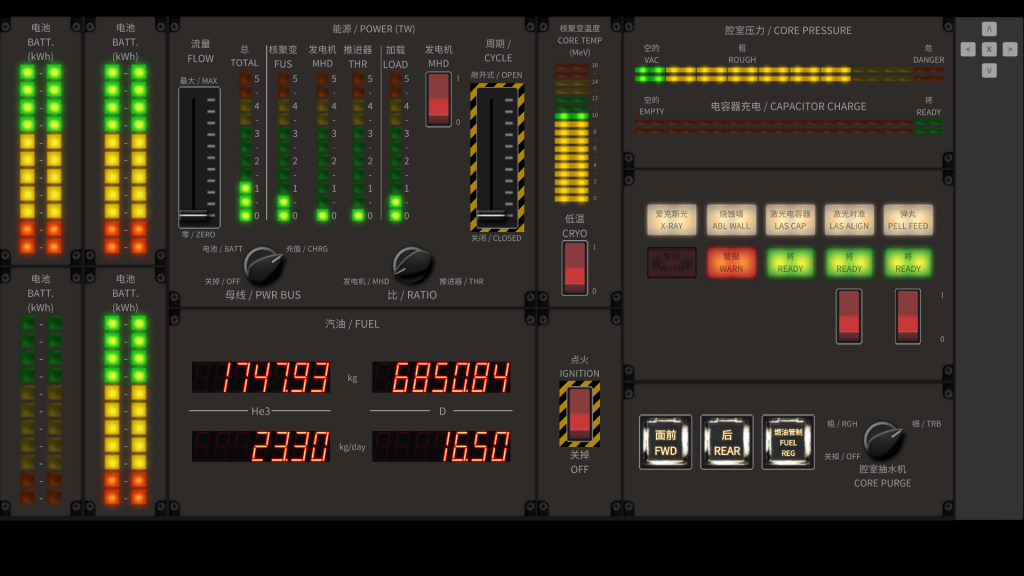
Dan Fedor loves to overwhelm players with informations.
TCG: The choice of the logo and the preview trailer show a clear link between NEO Scavenger and Ostranauts. Is this just a Blue Bottle Games signature or the two stories are going to be linked as well?
DF: Definitely linked stories. They take place in the same universe, and are contemporaneous. If you dig deep into the lore in NEO Scavenger, you’ll find occasional references to mining strikes in the Jovian System, and other references to a space economy. Earth has been cut off from space, however, and the two stories are unlikely to meet directly. This is more like a “meanwhile, in space” type story.
TCG: The independent videogames scene is huge nowadays, but how did it all start in your case? Can you tell us more about the main differences in the conception and in the development of NEO Scavenger and Ostranauts?
DF: It’s a long story! And if you want all the juicy details, I created a blog to record the journey and decisions during the first year or so. You can find that here. The brief overview is that I worked for 7ish years at BioWare, and eventually grew tired of just making tools for games. I wanted to make the game itself. So I saved up a bunch of money, did a bunch of research, and quit to give it a shot. NEO Scavenger was basically just me working out of my bedroom for the first year or so. As the game picked-up momentum, more people offered to help. And thankfully they did! I think the game is much better as a result of my collaboration with those in the game credits. Ostranauts was similarly just me at the start. But once it became public, I quickly started seeking out collaborators. This time around, I’ve had at least one collaborator as a contractor at almost any given time. Plus, with Modern Wolf as a publisher, I have a team dedicated to marketing, PR, testing, and business guidance. And that’s been a big help in freeing me up for development.
TCG: The psychological aspect of the characters has always been important in your games. In Neo Scavenger, for example, we don’t find the usual “classes division” of an RPG videogame, and we are asked to “pick and mix” some personality traits that will define our hero, in a sandbox way. How far will Ostranauts push the social dynamics we already know? And how hard is to balance the variables?
DF: Ostranauts takes everything I had in NEO Scavenger (mostly physical and knowledge traits), and adds emotional stats, plus a healthy amount of back-story. In the same way you managed hunger or warmth in NS, Ostranauts players will be managing esteem and security. I’d like for it to be as enjoyable and engaging as NS was, just broader. But only time will tell if I succeed!
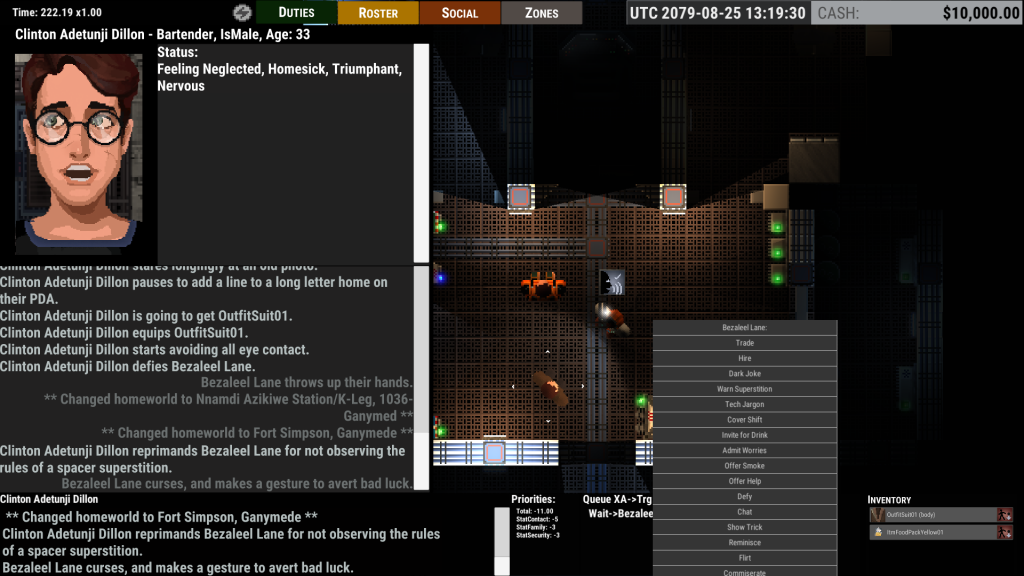
Characters look very well developed in both psychological and physical statuses.
TCG: One thing I liked of NEO Scavenger, was how the game evolved. My impression has been that you designed it in a way that, once our character reaches Detroit Megacity, the game knows the player already learnt the mechanics about surviving, and he is now ready for something new. Will Ostranauts also have a similar evolution?
DF: I think you give me more credit than I deserve. I mainly developed NS in an organic way, adding things I wanted to do as I realized I wanted them. Though, I guess that’s not a bad approach, since it probably reflects the path players want to take, too. In Ostranauts, I think it’ll go the same way. I’ve setup a lot of the basic systems first, so we can walk around, setup ship layouts, and make parts work together. I added NS-like personal needs to give us short term goals to work towards. And I added tools to address those needs. Items, actions you can use, a few derelicts to explore, and a nearby station to resupply at. I think this process will continue throughout development. But once a solid foundation of this is in place, there are some higher-order goals I’d like to start exploring. Things like having friends in trouble, enemies harassing you, other stations to explore, and lore to uncover.
TCG: NEO Scavenger was not only a game with a cyberpunk atmosphere but also a veritable punk product if we think how you encouraged the creation of a community, and the “hacking” of the game itself with the creation of MODS. Will Ostranauts also have this approach?
DF: Ostranauts is very much in line with NS in this regard. As mentioned earlier, it shares the same universe. And if anything, The System is even more of a capitalistic dystopia than Detroit Mega City in NS.
And modding support is still a major goal in the game. All of the data is in text json files, so anyone can edit them. And all of the sprites are PNG images for the same reason. There may be things I’m unable to expose to modding, for one reason or another. But I want people to not only play my games, but use them as storytelling tools for their own adventures.
TCG: Neo Scavenger was clearly not a mobile game at his beginning but you somehow managed to have it on smartphones… Was it hard? Was it worth it in its case? Is Ostranauts already conceived to be ported on other platforms? It looks like something I would love to play on Switch.
DF: It was hard. The games I make are very at-home on desktops, with a big screen and mouse and keyboard as inputs. So adapting it to a touchscreen was a challenge all it’s own. But then the mobile OSes were even harder. I needed outside help with those. I’ve never been more frustrated with development than trying to navigate those platforms. I’ll probably avoid them in the future as a result. I’m not sure about the Switch. I’ve only recently started thinking of checking one out, but alas, they’re sold out!
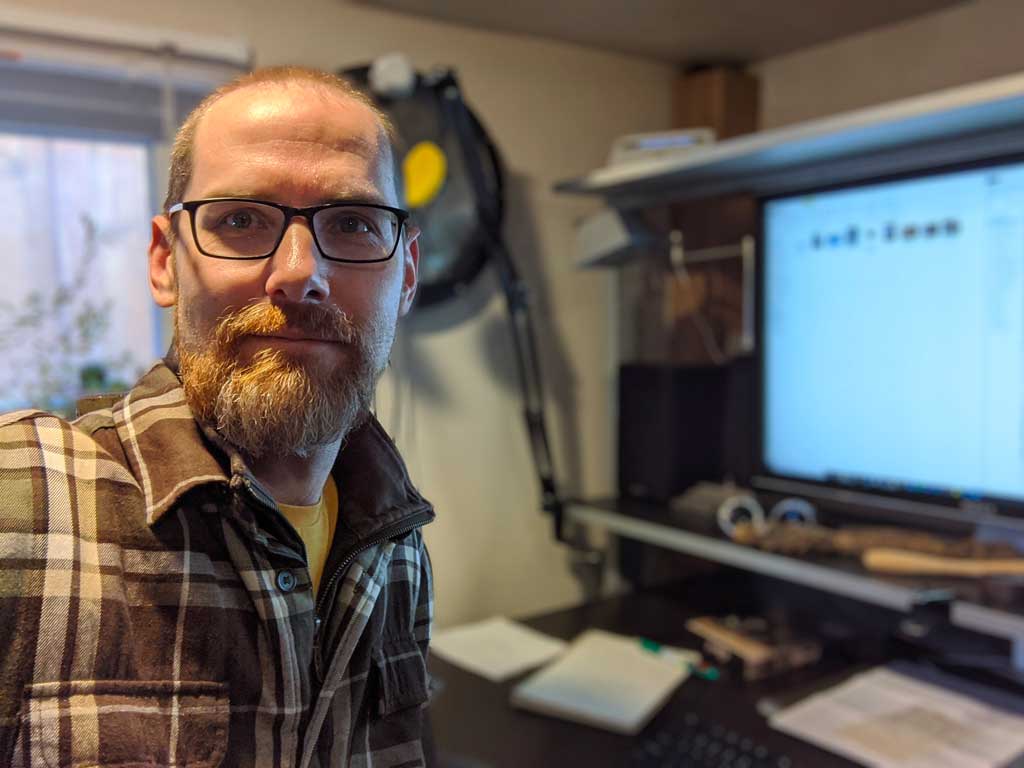
Dan Fedor looks much more friendly than his games!
TCG: Name 3 things that shaped your style and background. You can pick everything!
DF: Oof! There are too many to reduce to 3, but I’ll try. Rifts (RPG), Aliens (film), and Aphex Twin Selected Ambient Works Vol. 2 (album).
TCG: Which games are you playing at the moment? And what are you looking forward to play with?
DF: A lot of Risk of Rain with my family. Planetside 2 when I just want to bomb around without thinking. And honestly, I’m deep into a rut where I can’t figure out what game I want to obsess about next. Which is odd, given how many cool-looking games there are out there! I have been meaning to pick up Industries of Titan, though. The style alone looks so juicy. And the team that made it are really nice folks!




Your NEO Scavenger & Ostranauts in-universe stories wanted!
Hey Folks!
We're getting ready to share some in-universe communications from the world of Ostranauts, and we’d like you to take part in that!
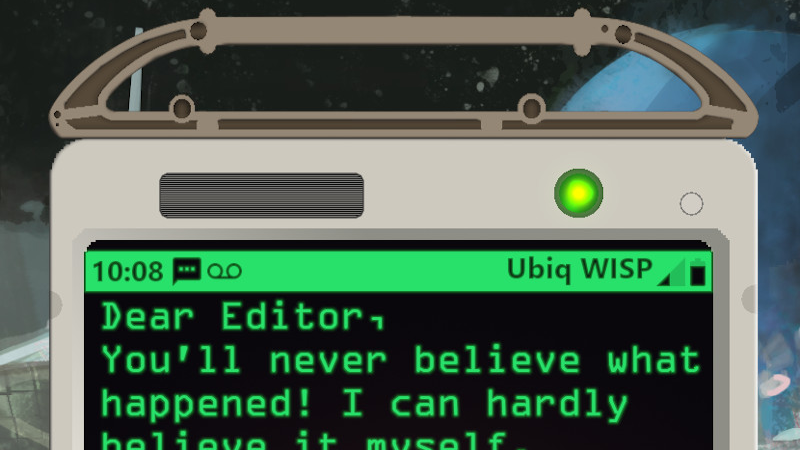
Please post your best in-universe tales on this reddit thread, inspired by your time in NEO Scavenger, and by the story trailer for Ostranauts.
Whether they be captain’s log last entries, rumors of Old-Earth told over a Bismertnaya on K-Leg, frantic 911 recordings of a cryptid event, or a letter of solidarity with the miners in the Jovian moons.
We'll select some of our favorites for inclusion in an in-universe communication coming soon!
Best,
Dan























OSTRANAUTS BLASTS OFF INTO EARLY ACCESS THIS JUNE
Captain your own crew to success or failure in noir spaceship-life sim Ostranauts!
Modern Wolf and Blue Bottle Games announce June date for Ostranauts Early Access release
London, UK // May 28, 2020 – Progressive indie publisher Modern Wolf and NEO Scavenger developer Blue Bottle Games are delighted to announce that Ostranauts will be available in Early Access on Steam from 11th June 2020.
In this noir spaceship-life sim, players start out as a spaceship captain and have to carefully hire a crew before attempting to survive in the savage world of a ravaged solar system. The game challenges players to design a one-of-a-kind spaceship, manage their rag-tag crew’s physical and emotional needs, whilst keeping their junker of a ship from falling apart. If that wasn't enough, there is always the looming threat of bankruptcy lingering over everyone’s heads, as well as fending off a whole host of chaotic problems that could be just around the corner…
Early Access for Ostranauts will start by allowing players to begin their adventure as a spaceship captain - fixing up their ship and getting it space worthy, whilst socialising with NPCs and kick-starting their salvaging career.
About Ostranauts
Ostranauts is a detailed simulation of owning and living aboard a spaceship, in a solar system where honest living is a slow death sentence. Set in the NEO Scavenger universe, where Earth has suffered cataclysmic collapse, the rest of the System lives on in a state of capitalistic dystopia.
Players can customise everything about their starting character including looks, name and pronoun preferences before setting out into the vast expanse of space. They will then build or customize their starting ship from the spoils of their career history, and find ways to keep their motley crew happy, fuel in their tanks, food on their plates, and the debt collectors at bay.
Succeed and shoot for the stars or crash and burn from the consequences of your actions!
Detailed Custom Ship Design
Players can build their ship, in any shape, from functioning modular parts. The parts have physical properties, interact with each other, and can wear out over time.
Crew Needs
Crew members have physiological and emotional needs, from basal necessities like food, water, oxygen, and temperature, to more esoteric needs like privacy, security, intimacy, and esteem.
Early Access
What can players expect in the first wave of Early Access:
- Assume the role of captain repairing your spaceship to get it ready for dust off
- Starting on shipbreaker career - salvaging from derelict ships around K-Leg station to get their junker ready to fly
- Socialising with NPCs
Additional:
- Fly to different worlds completing tasks, get more tools for characters and parts for the ship
- Encounter a variety of ship types, makes and models
- Combat elements - space battle and hand to hand
- Meeting with other ships - possible hostile encounters (you never know who to trust)
Ostranauts is now available to wishlist on Steam.
Further Information
Website: https://modernwolf.net/games/ostranauts
Steam Page: https://store.steampowered.com/app/1022980/Ostranauts/

![Glory to Codexia! [2012] Codex 2012](/forums/smiles/campaign_tags/campaign_slushfund2012.png)
![Have Many Potato [2013] Codex 2013](/forums/smiles/campaign_tags/campaign_potato2013.png)
![The Year of Incline [2014] Codex 2014](/forums/smiles/campaign_tags/campaign_incline2014.png)






























![Glory to Codexia! [2012] Codex 2012](/forums/smiles/campaign_tags/campaign_slushfund2012.png)
![Have Many Potato [2013] Codex 2013](/forums/smiles/campaign_tags/campaign_potato2013.png)
![The Year of Incline [2014] Codex 2014](/forums/smiles/campaign_tags/campaign_incline2014.png)





























Hell yeah, that's what I imagine space battle to be. Submarine warfare, not WWI airplanes in space, or two forts shooting guns at each other.What I'm picturing is ship battles done "through the scopes," using detection, identification, and countermeasures on readouts and control panels. Damage can already break or remove entire ship parts, and it'll be up to the crew to patch them, replace them, or seal them off. Probably the first taste of this in action will be ship collisions.
![Glory to Codexia! [2012] Codex 2012](/forums/smiles/campaign_tags/campaign_slushfund2012.png)
![Have Many Potato [2013] Codex 2013](/forums/smiles/campaign_tags/campaign_potato2013.png)
![The Year of Incline [2014] Codex 2014](/forums/smiles/campaign_tags/campaign_incline2014.png)


































Will space combat happen on its own module or does the whole simulation run at the same time?
Hell yeah, that's what I imagine space battle to be. Submarine warfare, not WWI airplanes in space, or two forts shooting guns at each other.

At least it will be easy to figure out who is going out the airlock.Andrea Hartman is gender neutral











